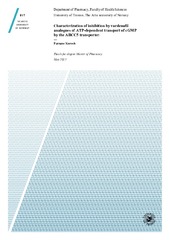| dc.contributor.author | Wen, Di | |
| dc.contributor.author | Lv, Hongxia | |
| dc.contributor.author | Yu, Hao | |
| dc.date.accessioned | 2025-04-29T07:05:16Z | |
| dc.date.available | 2025-04-29T07:05:16Z | |
| dc.date.issued | 2025-04-28 | |
| dc.description.abstract | Congestion in urban rail transit (URT) systems often results in passengers being left behind on platforms due to trains’ reaching capacity. Distinguishing between the travel choice behaviors of passengers who board the first arriving train (Type I passengers) and those who are left behind (Type II passengers) in passenger assignment is essential for effective URT passenger management. This paper proposes a data-driven passenger-to-train assignment model (DPTAM) that leverages automated fare collection (AFC) data and automated vehicle location (AVL) data to differentiate between the travel choice behaviors of the two types of passengers. The model comprises two modules based on passenger travel choice behavior: the passenger route choice model (PRCM) and the passenger itinerary choice model (PICM). The PRCM employs a granular ball–based density peaks clustering (GB-DP) algorithm to estimate passengers’ route choices based on historical data, enhancing precision and efficiency in passenger classification and
route matching. The PICM incorporates tailored itinerary selection strategies that consider train capacity constraints and schedules, enabling accurate inference of passenger itineraries and localization of their spatiotemporal states. The model also estimates train loads and left-behind probabilities to identify congested periods and sections. The effectiveness of DPTAM is validated through synthetic data, demonstrating superior assignment accuracy compared to benchmarks. Additionally, real-world data from Chengdu Metro reveal the impact of congestion on travel behavior and effectively identify congested periods and
high-demand stations and sections, highlighting its potential to enhance URT system efficiency and passenger management. | en_US |
| dc.identifier.citation | Wen, Lv, Yu. Data-driven Approach for Passenger Assignment in Urban Rail Transit Networks: Insights from Passenger Route Choices and Itinerary Choices. Journal of Advanced Transportation. 2025 | en_US |
| dc.identifier.cristinID | FRIDAID 2369347 | |
| dc.identifier.doi | 10.1155/atr/6620828 | |
| dc.identifier.issn | 0197-6729 | |
| dc.identifier.issn | 2042-3195 | |
| dc.identifier.uri | https://hdl.handle.net/10037/36958 | |
| dc.language.iso | eng | en_US |
| dc.publisher | Wiley | en_US |
| dc.relation.journal | Journal of Advanced Transportation | |
| dc.rights.accessRights | openAccess | en_US |
| dc.rights.holder | Copyright 2025 The Author(s) | en_US |
| dc.rights.uri | https://creativecommons.org/licenses/by/4.0 | en_US |
| dc.rights | Attribution 4.0 International (CC BY 4.0) | en_US |
| dc.subject | VDP::Teknologi: 500::Bygningsfag: 530::Bygg-, anleggs- og transportteknologi: 532 | en_US |
| dc.subject | VDP::Technology: 500::Building technology: 530::Building, construction and transport technology: 532 | en_US |
| dc.subject | Intelligente Transportsystemer / Intelligent Transportation Systems | en_US |
| dc.subject | Transport / Transportation | en_US |
| dc.subject | Transportplanlegging / Transportation planning | en_US |
| dc.title | Data-driven Approach for Passenger Assignment in Urban Rail Transit Networks: Insights from Passenger Route Choices and Itinerary Choices | en_US |
| dc.type.version | publishedVersion | en_US |
| dc.type | Journal article | en_US |
| dc.type | Tidsskriftartikkel | en_US |
| dc.type | Peer reviewed | en_US |


 English
English norsk
norsk



